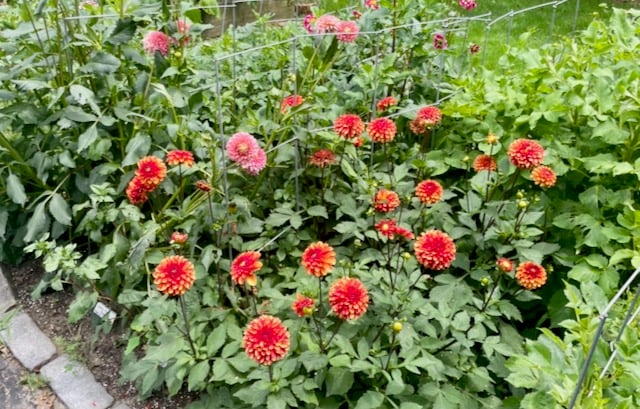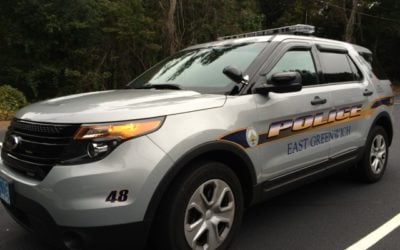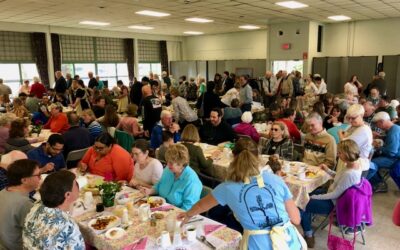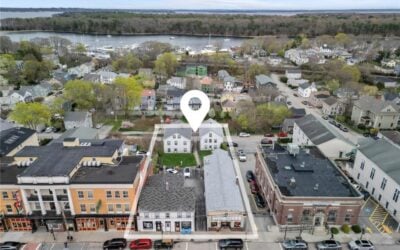Above: Dahlia. Photo courtesy of Kristie Stark
… and if they are, tell them George says, Stop!’
By George Christie
Despite the cool weather, spring is actually advancing on us fairly quickly. The daffodils are coming into full bloom and tulips won’t be far behind. In my native plant garden, the near-native Jacob’s Ladder is coming on strong, and the columbine is showing growth. I even paused yesterday to look at some funny “leaf litter” in my shade garden, taking a second to realize the wild ginger had popped up seemingly while I was at work.
Of course, this also means native-plant people like me will be all over the place reminding you about the importance of planting native plants and another “Save the pollinators” sign will pop up in a neighbor’s “unkempt” yard. And there you are, standing by your front bed with your dahlia tubers, saved from your grandmother’s yard, years ago when she moved to Florida.
Please plant them, and when they come up and flower, please enjoy them. Because native gardening is about connections, and how can we re-form the connections with the earth that people used to have, if we deny ourselves the plants our ancestors loved?
In some ways the most important question to ask before choosing to plant a given plant isn’t, “Is it native?” but rather, “How does this connect me with nature?” Accepting that humans are of nature, to plant in remembrance of loved ones is as valid as to plant for butterflies to be. Further, once we start the process of asking “How does this plant connect me with nature?”, we start to recognize the many ways we can shape our gardens to better connect with the Rhode Island we call home.
Yes, the latest research all agrees locally native plants are, on average, better connected to the local web of life. But the work done by Doug Tallamy and his graduate students also strongly suggests a few choice plants from around the world do not significantly impact the value of your garden. The white-flowering rhododendron I planted when my father died may not draw luna moths to lay their eggs, but it might serve as a nesting location for a Carolina wren. We have a rose of sharon at one corner of our house, non-native for sure, but there is at least one species of bee that loves its flowers in late summer. We do too. Of course, I have to trim off every seed pot before they split, because I hate, hate, hate those flip-flop piecing seedlings everywhere, but we feel it’s a fair trade off.
I believe the path to a Rhode Island garden should be dominated by the plants that have been here for far longer than that name. But I also believe there needs to be room for the new and the different, else, honestly, where would I call home? In past centuries the forest outside the cabin door was seen as an alien world to be tamed by the axe and the familiar flora of home. But we’re home now. The cabin is gone, as is most the woods. We now know that, if we want the colorful songbirds at our feeders, if we want our children to understand lightning bugs and butterflies, if we want our blueberry bushes ripe with fruit, what we once so forcefully pushed away we must invite back into our lives. Still, even in understanding this, we need to leave room for the flowers our grandparents courted by, the cooking smells of the herbs and vegetables which reminded our ancestors of the old country, and the trees planted by loved ones years ago so that we might rest in their shade when our workday is done.
And so, I return to connection. Yes, a garden is a physical thing of plants and paths, earth and stone. But it also memory and hope, the lawn where grown children once battled long and hard at croquet or the yearly floral display beloved by an aging parent. I have been very lucky. In this season of renewal, I cannot kneel at the garden’s edge without a parent’s voice and hand there to share the texture of the soil, the shape of the roots, and the smell of this day’s flower. So, I plant the columbine and trillium and coral bells of my youth and watch eagerly for the double-file viburnum to bloom, so that I can say out loud, “Viburnum are the queens of the garden,” as my dad once said to me.
But the gardens of my youth were also surrounded by the woods and meadows of my youth, so the zinnias which could not possibly produce a swallowtail butterfly, still drew them in for the nectar, because the caterpillars had so many other native plants upon which to grow. We do not have the luxury of asking the wild places to populate our gardens. The connections are too far gone. It is therefore up to us to define our own luck, our new luck, our garden where we remember the love that gave us our dahlias and cherish the hope that charts a new path through an old meadow, abuzz with the morning bumble bee, ablaze with the noonday flower, and alight with the lightening bug at dusk after which generations to come deserve to scamper, crying, “Aw PLEASE, just a few minutes more!”
George Christie studied entomology and landscape architecture and has worked in mosquito control, environmental education and garden design and plant sales. He currently works for the Rhode Island Natural History Survey managing their rare species database.






 Subscribe
Subscribe
Our yard is mostly local cuisine for the pollinators, but at least the bumble bees seem to enjoy going out for Mexican food in the dahlia bed!
We’ve found the bumble bees like our dahlias as well!
I love the sentiment about the family connections also being important as we try to support our local pollinators. I have my grandfathers peony that I still enjoy but you can’t beat the fun of watching the pollinators on a mountain mint!
Hi Kate! Peonies are another wonderful flower that often connect us to past gardens. And yes, mountain mint is a powerhouse pollinator plant. If you need more, my seeds are germinating slowly, but I hope have at least one tray of P. tenufolium to give away in late May. I think I sent you my list–let me know what you’re interested in.